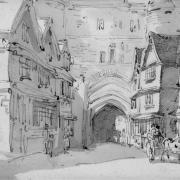Local historian, Chris Hallam, takes a look at the history of HM Prison Dartmoor
In the early years of the 19th Century, authorities sought a new solution to an all too familiar problem: Britain’s prison population was growing and growing fast.
With numbers rising rapidly as a result of the large numbers of French prisoners captured in the ongoing Napoleonic Wars, the tried and tested idea of prison ships was falling out of favour. For one thing, conditions on these large redundant warships, known as ‘hulks’ anchored in Plymouth and other places were increasingly considered unacceptable even by pre-Victorian standards. There also seemed a very real risk that some of the inmates might easily be able to escape, swim across Plymouth Sound and go on to cause mischief in the surrounding area.

A new prison was needed and it was decided the village of Princetown on Dartmoor – a bleak spot some 1,400 feet above sea level - was the place to build it. News of the forthcoming construction of the new prison was a definite boost to Sir Thomas Tyrwhitt, a well-connected old Etonian, MP for Okehampton and later Plymouth, and close friend of the future King George IV. He was responsible for setting up the prison and its construction used boulders supplemented by dressed stone drawn from Tyrwhitt’s own Herne Hole quarry. The Foundation Stone was laid on March 20, 1806, although the whole process was delayed by occasional labour disputes and by the inevitable rigours of the harsh Dartmoor weather.
The first prisoners arrived on May 22, 1809. By the end of the year, the prison was already full and overcrowding became an issue once again. With the outbreak of the War of 1812 between Britain and the newly established USA, things got even worse. Around 6,500 captured American sailors joined the French inmates. By the end of 1813, over 9,000 men were crammed in. Outbreaks of typhoid, smallpox and cholera became widespread.

In one particularly nasty incident guards opened fire on a crowd of American prisoners who they suspected (wrongly, as it turns out) of being about to start a riot. Seven men lay dead when the smoke cleared. Many others, perhaps as many as 60 were injured. With the French and Americans defeated by the end of 1815 and the inmates sent home, the prison lay deserted for a long time. Thomas Tyrwhitt’s dream lay in tatters. He died a poor man in 1833.
By 1846, every colony except Western Australia was fed up of the long-running policy of transporting Britain’s criminals overseas. More prison space was thus needed even more urgently. Dartmoor reopened in 1850, this time as a penal colony for actual homegrown criminals rather than for prisoners of war.

War did play a part in the prison’s future, however. In 1916, half-way through the First World War, conscription was introduced in a bid to end the desperate stalemate on the Western Front. With a few exceptions, all single men between the ages of 18 to 40 were now required for military service. Many objected and refused to fight on moral grounds, however. Unpopular and frequently stigmatised, many of these conscientious objectors faced imprisonment. In 1917, a thousand ‘conchies’ found themselves in Dartmoor.
The prison reopened for ordinary convicts again in 1920.
In 1932, nearly 200 prisoners went on the rampage after a riot broke out during the inmates’ morning exercises. The Governor and a visiting Home Office visitor were lucky to escape with their lives. When the dust settled, it emerged that the riot had been part of an ambitious mass escape attempt – which failed.
Since 2002, HMP Dartmoor has held low category prisoners only. The days of armed guards, punishment beatings and hard labour are in the past. Indeed, for a while it seemed as if the prison itself was destined to become a monument to history. In 2019, it was announced that HMP Dartmoor would close in 2023, bringing two centuries of prison history to an end. This has now changed. In December 2021, it was decided that Dartmoor Prison would remain open for this year and beyond.

PRISONS IN ENGLAND
Modern law and order in England developed after the Norman Conquest in 1066. Dating from 1188, Newgate Prison was built under Henry II, with the idea of juries and law books coming in around the same time. Although Magna Carta (1215) enshrined the principle that nobody could be imprisoned without first facing trial, the simple truth was that prison life remained very rough indeed for centuries. Prisoners were kept on bread and water and were even routinely charged money by jailers simply to receive the basic necessities.
In the 18th Century, prison ships were introduced and inmates were also transported to America and Australia in a bid to reduce overcrowding. In the 19th Century, Elizabeth Fry campaigned for prison reform and some change did come as innovations first suggested by philosopher Jeremy Bentham and Howard League founder, John Howard in the previous century were finally implemented.



























